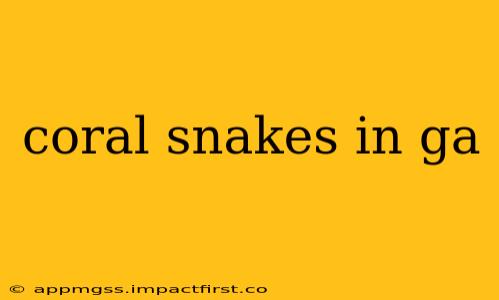Georgia is home to a fascinating array of wildlife, and among the most striking and potentially dangerous are its coral snakes. These venomous serpents, with their vibrant and distinctive coloration, often spark both curiosity and concern. This guide delves into the world of Georgia's coral snakes, providing crucial information on identification, habitat, behavior, and what to do in case of an encounter.
What types of coral snakes live in Georgia?
Georgia boasts one primary species of coral snake: the Eastern Coral Snake ( Micrurus fulvius). While other species might be encountered in neighboring states, the Eastern Coral Snake is the only one you're likely to find within Georgia's borders. It's crucial to be able to differentiate this snake from its non-venomous mimics.
How can I tell the difference between a coral snake and a non-venomous mimic?
This is a critical question, as several harmless snakes mimic the coral snake's striking coloration. The most common mnemonic device is the rhyme: "Red on yellow, kill a fellow; red on black, venom lack." However, this isn't foolproof, and relying solely on this can be dangerous. Careful observation of the following features is necessary for accurate identification:
- Color Bands: Coral snakes have distinct bands of red, yellow (or orange), and black. These bands are generally complete rings around the body. Mimics often have broken or incomplete bands.
- Band Width: Pay attention to the width of the bands. In coral snakes, the red bands are typically wider than the black bands.
- Head Shape: Coral snakes have a relatively small, rounded head that isn't distinctly separated from the neck. This is in contrast to many non-venomous mimics.
- Snout Shape: The snout of a coral snake is generally blunt and rounded.
Important Note: If you are unsure if a snake is a coral snake, it's best to assume it is venomous and avoid contact.
Where do coral snakes in Georgia live?
Eastern Coral Snakes prefer habitats with loose soil or leaf litter for burrowing. You'll often find them in:
- Pine Flatwoods: These areas provide the loose, sandy soil they need.
- Longleaf Pine Ecosystems: Similar to pine flatwoods, these habitats offer suitable burrowing conditions.
- Coastal Plains: This region of Georgia offers the ideal environment for the Eastern Coral Snake.
Are coral snakes aggressive?
Eastern Coral snakes are not inherently aggressive. They are shy and secretive snakes, preferring to avoid confrontation. They only bite as a defense mechanism when they feel threatened. However, their venom is potent, making avoidance crucial.
What should I do if I see a coral snake?
- Admire from a distance: Observe the snake without approaching or attempting to handle it.
- Keep pets away: Prevent your pets from interacting with the snake.
- Do not attempt to kill it: Coral snakes play a vital role in the ecosystem.
- Educate others: Share your knowledge about coral snake identification and safe practices.
What should I do if I'm bitten by a coral snake?
A coral snake bite is a serious medical emergency. Seek immediate medical attention. While the amount of venom injected can vary, antivenom is available and should be administered as soon as possible. Remain calm, and try to remember details about the snake (if possible, take a picture from a safe distance).
What is the venom of a coral snake like?
The venom of the Eastern Coral Snake is neurotoxic, meaning it affects the nervous system. Symptoms can include drowsiness, nausea, vomiting, and muscle weakness. In severe cases, respiratory failure can occur.
How common are coral snake bites in Georgia?
Coral snake bites are relatively rare in Georgia due to the snakes' shy nature and avoidance of humans. However, the potential severity of the bite necessitates caution and awareness.
This comprehensive guide provides valuable information on coral snakes in Georgia. Remember, prevention is key—knowing how to identify them and respecting their space can help ensure a safe encounter. Always err on the side of caution when dealing with any wild animal, especially venomous snakes.
